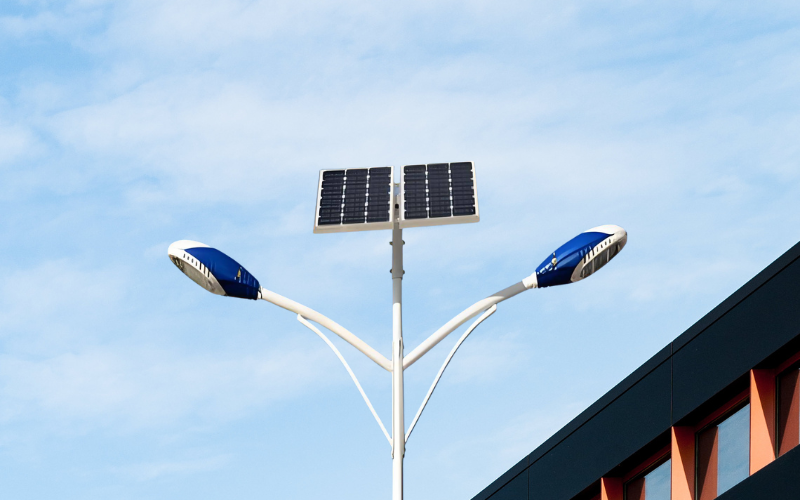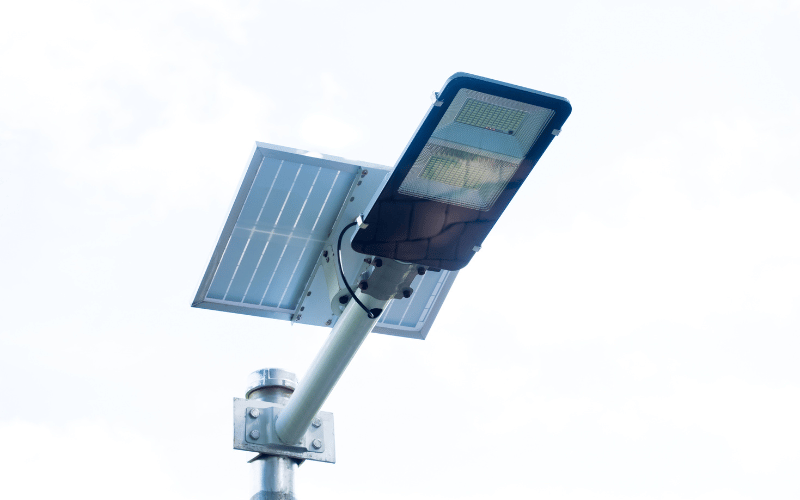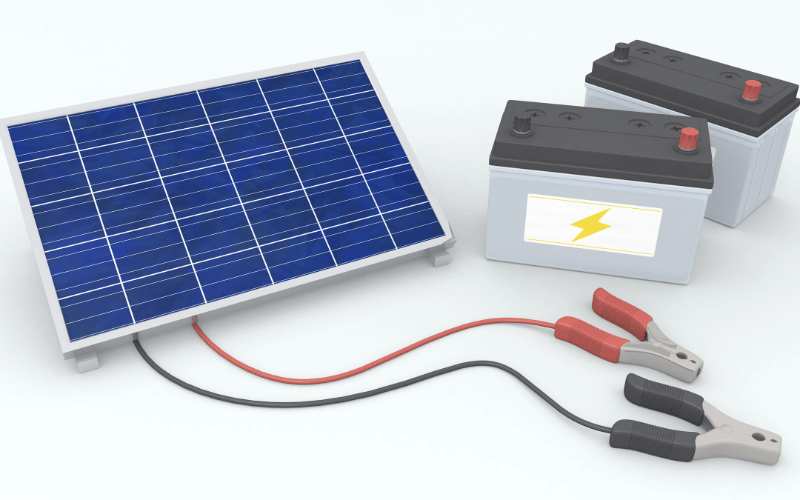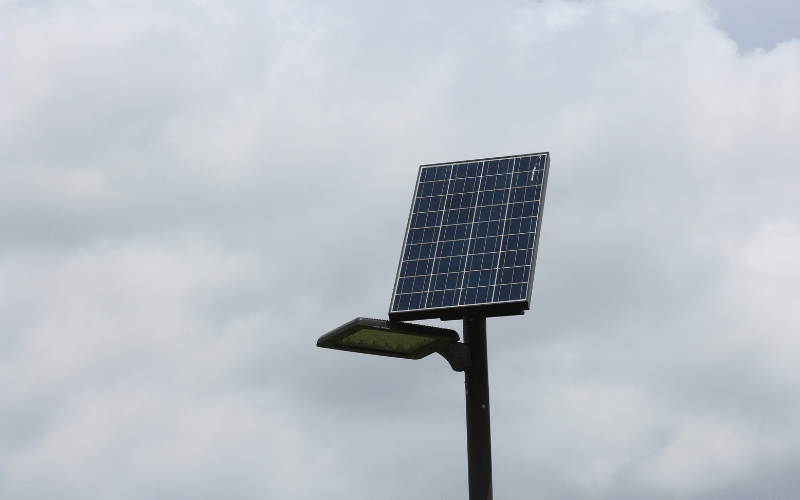Solar street lights are a sustainable and cost-effective solution for outdoor lighting, but they come with challenges that can’t be ignored. From weather dependency and battery limitations to higher upfront costs, these factors can impact their performance and reliability. By understanding these limitations and exploring innovative solutions, you can make informed decisions about whether solar street lights are the right fit for your needs.
Table of Contents
ToggleThe Sun Dependency Challenge
Weather Woes and Cloud Cover
Solar panels are at their best under direct sunlight, but what happens when the sky is gray? The impact of weather is significant. Heavy cloud cover can reduce energy production by a staggering 75-90% compared to a clear, sunny day. Even light cloud cover can cause a drop in output by 10-25%. Rainy conditions further limit power generation, as the combination of clouds and water on the panel surface scatters and blocks sunlight.
For example, in regions like the Pacific Northwest, extended periods of overcast weather can strain battery storage systems, which may struggle to recharge fully. To counter this, many modern solar installations in places like Seattle incorporate high-capacity batteries and smart energy management systems. These systems store excess power generated on sunny days to ensure a consistent supply during prolonged cloudy spells.
Geographic and Seasonal Variations
The amount of energy a solar panel can produce is directly tied to its location on the globe and the time of year. Locations near the equator, such as Kenya, benefit from intense, consistent sunlight year-round. This has enabled the successful deployment of solar microgrids that provide reliable electricity to remote communities.
In contrast, regions farther from the equator face a “solar winter.” During these months, not only are days shorter, but the sun is also lower in the sky. This lower angle means sunlight passes through more of the Earth’s atmosphere, reducing its intensity. For instance, in Berlin, Germany, a solar panel system can produce up to five times more energy in July than it does in December.
To address these seasonal dips, installers often adjust the tilt of solar panels to capture the low-angle winter sun better. Another innovation is the use of bifacial solar panels. These panels can capture reflected light from the ground on their rear side, boosting energy production by up to 30%, which is especially useful during snowy winter months when the ground is highly reflective.
Battery Storage: The Power Pack’s Limits
Battery Lifespan and Degradation
Batteries are the backbone of solar systems, storing energy for nighttime use. However, like all technology, they degrade over time, losing efficiency and reliability. Most solar batteries last between 3 to 7 years, depending on factors like usage patterns, environmental conditions, and maintenance. For instance, lithium-ion batteries, while more expensive upfront, often outlast lead-acid alternatives, offering better long-term value.
Dr. Anya Sharma, a Renewable Energy Analyst, notes, “Battery technology is improving, but it remains a bottleneck for long-term reliability.” This underscores the importance of choosing high-quality batteries and planning for periodic replacements to maintain system performance. Regular maintenance, such as checking for corrosion and ensuring proper charging cycles, can also extend battery life and reduce unexpected costs.
Capacity and Runtime Constraints
The capacity of a battery directly impacts how long solar street lights can operate. For example, a 100Ah battery might power a light for 10 hours, but heavy usage or extended cloudy days can drain it faster, leading to dimming or shutdowns. This is particularly critical in regions with unpredictable weather or high energy demands.
To mitigate these risks, it’s essential to design systems with batteries that align with expected power needs. For instance, pairing solar lights with smart energy management systems can optimize energy usage, ensuring lights remain functional even during high-demand periods. Additionally, hybrid solutions, such as combining solar with grid power or wind energy, can provide backup during extended low-sunlight conditions.
Initial Cost and Maintenance Hurdles
Upfront Investment Analysis
Solar street lights often come with a higher upfront price tag compared to traditional lighting systems. For instance, while a conventional street light might cost $1,000–$1,500 per unit (including installation), a solar street light can range from $2,000–$3,000 or more, depending on the quality of components like solar panels, batteries, and specialized poles. Additionally, installation requires skilled labor to ensure proper alignment and system integration, which can further increase costs.
However, these higher initial expenses are offset by long-term savings. Solar street lights eliminate electricity bills and reduce maintenance costs associated with underground wiring. Studies show that despite being 20-40% more expensive upfront, solar systems can achieve a full return on investment (ROI) within 5-7 years, especially in areas with high electricity rates or government incentives for renewable energy adoption.
Ongoing Maintenance Needs
Proper maintenance is essential to maximize the efficiency and lifespan of solar street lights. For example, solar panels can lose up to 20% of their energy output if covered in dirt, dust, or debris. In regions prone to heavy dust or pollution, panels may require cleaning as often as once a month.
Battery maintenance is another critical factor. Lithium-ion batteries, while more durable, still require periodic inspections to ensure proper charging cycles and to identify early signs of degradation. In extreme climates, where temperatures can affect battery performance, additional protective measures like thermal insulation may be necessary. Over time, components such as batteries (typically replaced every 5-7 years) and LED fixtures may need replacement, adding to the maintenance workload.
Key Recommendations
To ensure optimal performance and longevity:
Quarterly Maintenance: Schedule regular cleaning of solar panels, especially in dusty or polluted areas, using non-abrasive tools and water.
Battery Inspections: Conduct biannual checks to monitor battery health and charging efficiency.
Component Replacement Planning: Budget for battery and LED replacements every 5-7 years to avoid unexpected costs.
Smart Monitoring Systems: Consider integrating remote monitoring systems to track performance and identify issues in real time, reducing manual inspections.
Performance and Reliability Concerns
Light Output Variations
The brightness of solar street lights can fluctuate based on the energy stored in their batteries. For instance, on cloudy or rainy days, solar panels may generate significantly less energy, leading to dimmer lights at night. This can reduce visibility and compromise safety in public spaces, particularly in high-traffic areas.
To address this, modern systems are incorporating adaptive lighting technologies that adjust brightness based on real-time conditions, such as motion detection or ambient light levels. Additionally, using high-capacity lithium-ion batteries or hybrid systems (solar combined with grid power) can ensure consistent performance even during extended periods of low sunlight. For example, some cities have implemented systems with backup power sources that activate during cloudy weather, maintaining full brightness and reliability.
Vandalism and Security Risks
Solar street lights, often installed in open and remote areas, are vulnerable to theft and vandalism. Components like solar panels and batteries are particularly at risk due to their high resale value. For example, reports from some rural installations indicate that up to 10% of systems experience theft or damage within the first year.
To mitigate these risks, urban planners are adopting several security measures:
Reinforced Casings: Protective cages or tamper-proof designs for batteries and panels significantly reduce theft.
GPS Tracking: Some systems now include GPS trackers to locate stolen components.
Community Monitoring: Engaging local communities to monitor and report suspicious activity has proven effective in reducing vandalism.
Smart Surveillance: Integrating cameras or motion sensors with solar lights can deter potential theft and provide real-time alerts.
While these measures may increase upfront costs, they greatly enhance the system’s longevity and reliability, making them a worthwhile investment.
Key Recommendations
Design for Reliability: Use adaptive lighting systems and high-capacity batteries to ensure consistent brightness, even in challenging weather conditions.
Enhance Security: Invest in tamper-proof designs, GPS tracking, and community-based monitoring to protect components from theft or vandalism.
Plan for Backup: Consider hybrid systems or backup power sources to maintain performance during extended low-sunlight periods.
Environmental and Material Factors
Manufacturing Footprint
The production of solar panels is resource-intensive, requiring significant energy and materials. For example, manufacturing a standard silicon-based solar panel can generate a carbon footprint of 20-40 grams of CO₂ per kilowatt-hour over its lifecycle. Additionally, rare metals like cadmium, tellurium, and indium, often used in solar panels, are not only difficult to source but can also raise ethical concerns related to mining practices.
Disposal of old or damaged panels presents another challenge. Components like lead and cadmium can be toxic if not properly recycled. However, advancements in solar panel recycling technologies are helping to address this issue. For instance, some facilities can now recover up to 95% of materials from decommissioned panels, reducing waste and environmental impact. Conducting a life cycle assessment (LCA) is essential to evaluate the overall sustainability of solar systems, factoring in both manufacturing and end-of-life processes.
Temperature Sensitivity
Solar systems are highly sensitive to temperature extremes, which can significantly impact their performance. For instance, solar panel efficiency typically decreases by 0.3-0.5% for every degree Celsius above 25°C. In contrast, very low temperatures can reduce battery storage capacity, leading to shorter runtimes and potential system failures.
To mitigate these issues, manufacturers are developing temperature-regulating designs, such as panels with anti-reflective coatings to reduce heat absorption and batteries with thermal insulation to maintain optimal performance in extreme climates. For example, solar systems in desert regions often incorporate passive cooling systems, while those in colder climates use heating elements to protect batteries from freezing.
Key Recommendations
Choose Sustainable Options: Opt for solar panels from manufacturers that prioritize ethical sourcing and offer recycling programs for end-of-life panels.
Conduct a Life Cycle Assessment: Evaluate the environmental impact of solar systems, from production to disposal, to make informed decisions.
Design for Climate: Select solar systems specifically engineered for your region’s temperature conditions, such as heat-resistant panels or insulated batteries, to ensure optimal performance and durability.
Frequently Asked Questions
Q: What are the main limitations of solar street lights?
A: Solar street lights face several challenges, including dependency on sunlight, battery degradation, higher upfront costs, and vulnerability to theft or vandalism. Weather conditions, such as heavy cloud cover or prolonged rainy periods, can significantly reduce energy production. Additionally, batteries require periodic replacement, and the initial investment for solar systems is higher compared to traditional lighting. However, proper planning and innovative solutions can help mitigate these limitations.
Q: How does weather affect the performance of solar street lights?
A: Weather plays a crucial role in the efficiency of solar street lights. Heavy cloud cover can reduce energy production by 75-90%, while even light clouds can cause a 10-25% drop. Rainy conditions further limit power generation by scattering and blocking sunlight. In regions with frequent overcast weather, high-capacity batteries and smart energy management systems can help maintain consistent performance.
Q: Why do solar street lights have higher upfront costs?
A: Solar street lights are more expensive initially because they require specialized components like solar panels, batteries, and poles. Installation also demands skilled labor to ensure proper alignment and integration. While the upfront cost is higher, these systems eliminate electricity bills and reduce maintenance costs, often achieving a return on investment within 5-7 years.
Q: How long do the batteries in solar street lights last?
A: Most solar batteries last between 3 to 7 years, depending on their type, usage, and maintenance. Lithium-ion batteries, while more expensive, generally last longer and offer better performance compared to lead-acid batteries. Regular maintenance, such as checking for corrosion and ensuring proper charging cycles, can extend battery life.
Q: What measures can prevent theft or vandalism of solar street lights?
A: To reduce theft and vandalism, many systems incorporate tamper-proof designs, reinforced casings, and GPS tracking for components like batteries and solar panels. Community monitoring and smart surveillance systems, such as cameras or motion sensors, can also deter potential theft and provide real-time alerts.
Q: How can solar street lights perform better in extreme climates?
A: In hot climates, solar panels with anti-reflective coatings and passive cooling systems can reduce heat absorption and maintain efficiency. In cold regions, batteries with thermal insulation or heating elements can prevent freezing and ensure reliable performance. Choosing systems designed for specific climate conditions is essential for optimal durability and efficiency.
Q: Are solar street lights environmentally friendly despite their manufacturing footprint?
A: While manufacturing solar panels requires significant energy and materials, their long-term environmental benefits outweigh the initial impact. Panels typically have a carbon footprint of 20-40 grams of CO₂ per kilowatt-hour over their lifecycle. Recycling technologies now allow up to 95% of materials from decommissioned panels to be recovered, further reducing waste and environmental impact.
Conclusion:
Solar street lights combine eco-friendliness with long-term cost savings, but they aren’t without their hurdles. Weather conditions, battery degradation, and security risks are just a few of the challenges to consider. However, with proper planning, smart system designs, and regular maintenance, these limitations can be mitigated. By addressing these factors, you can ensure a reliable and efficient solar lighting system that meets your needs.





